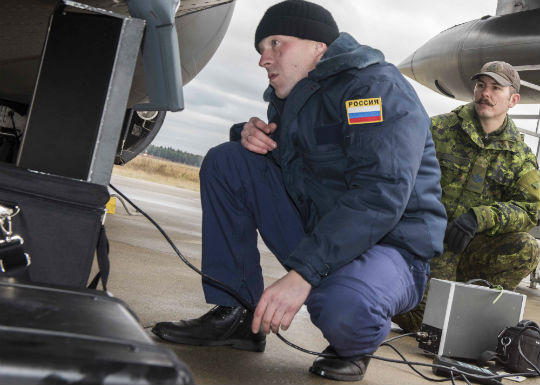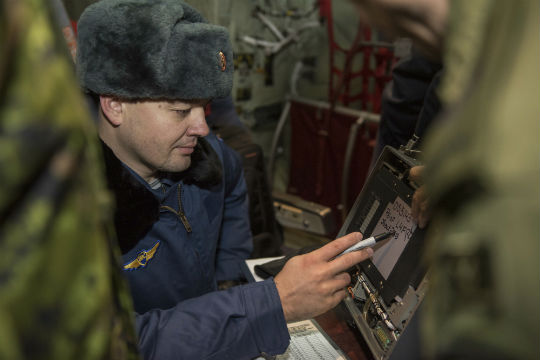A Canadian Air Force CC-130J Hercules transport returned to CFB Trenton recently after four surveillance missions over Russia. The crew recorded images of airfields, cities, factories and military exercises.
Maj Sylvain Collard of the arms control verification unit said the flights were uneventful but offered no clues as to what was seen.
The Russian Federation approved the flights in accordance with the little-known Treaty on Open Skies, which establishes a regime of unarmed aerial observation flights over the territories that have signed it. A goal of the treaty is to enhance understanding and confidence among participants by giving them a direct role in gathering information through aerial imaging.
The Open Skies treaty came into effect in 2002 and 34 countries have signed it. Each state has annual quotas for the number of flights it may fly or receive. Requests to over fly another country require 72 hours’ notice, and must be answered in 24 hours. Canada permits 12 flights a year, and Russia is allowed six of those flights.
Members of the National Nuclear Risk Reduction Center of the Russian Federation inspect the radome of an RCAF CC-130J under the Treaty on Open Skies, at Russian Air Force Base Kubinka, near Moscow on Sept. 22, 2015. MCpl France Morin Photo
Aircraft may carry up to four types of sensing equipment: video cameras, optical framed and panorama cameras, synthetic aperture radar and infra-red line scanners. All such equipment must be available commercially to anyone, and have maximum ground image resolutions, in the case of videos, of 30 centimetres. That’s fine enough to distinguish a pickup truck from a sedan.
Aircrews must follow detailed protocols. Planes must arrive at a designated place in the host country where the aircraft and its sensing equipment are inspected.
Sensors must be turned off if the flight is diverted from its flight plan. Flights may not cross a point twice or circle or fly less than 10 kilometres from a national boundary. Unless another agreement is reached, the observing party must leave within 24 hours of completing the mission.
The usual Hercules crew is five persons, but 10 are carried in case of health or technical contingencies. Also aboard are Canadian Arms Control Verification specialists and interpreters. Some flights carried observers from Portugal, Poland and Spain. Periodic training flights are conducted with allies.
A Russian inspector from the National Nuclear Risk Reduction Center of the Russian Federation certifies the aerial film loaded inside a KS-87B film magazine at Russian Air Force Base Kubinka near Moscow on Oct. 28, 2015. Cpl Lindsay Neifer Photo
Russia provided a crew to ensure the Canadians followed the agreed flight plan. Two flight monitors, an interpreter and one monitor per sensor control station suggest nothing is left to chance. Russia, like any treaty signatory, can request data and images of any member, including itself. “At my level, the Russians have been cooperative, professional and well trained, said Maj Collard.
A typical RCAF observation flight takes off from CFB Trenton, refuels on the east coast, picks up the “pod” containing the sensors in France and arrives in Moscow after about 12 to 15 flying hours. Trips to Bosnia, the Ukraine and Georgia are a few hours shorter. All sensors are in a modified fuel tank hung under one wing. Canada owns the pod but France also uses and stores it.
After the inspection, flight planning takes a day. That’s because Canada is allowed to fly 5,000 kilometres from Moscow, sometimes in over 30 legs. Hazardous air space, threats and risks are given special attention. In 2014, fighting in the Ukraine caused Canada’s flight to divert. The typical mission budget is $42,000.
An RCAF CC-130J Hercules with a SAMSON photo pod on its port wing flies over Bricy Air Base, France on June 4, 2015. Armée de l’air du France Photo
The Open Skies call sign is a minor benefit, providing priority over airliners and other traffic except emergency planes. A Nav Canada rep did not know if a Russian aircraft over Canada would have priority over the Queen’s. When airways were named after colours (i.e. red three), one would be renamed “purple” to proclaim the Queen’s priority. Because snow on the ground conceals military activities, no more flights are planned for 2015. The only Canadian unit to fly Open Skies missions, 436 Squadron, will continue training before resuming patrols over Russia, the Ukraine, Georgia and Bosnia in spring 2016.
Russia made observation flights with on-board Canadian observers to Edmonton and Halifax in the last two years. By Dec. 7, 2015 Russia had not used its allowed annual flight over Canada







